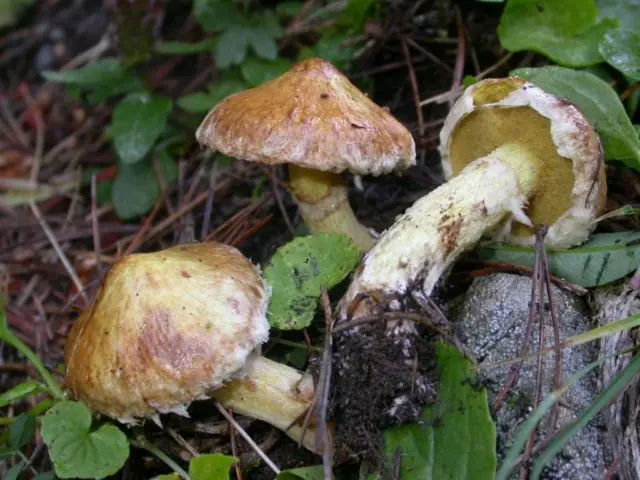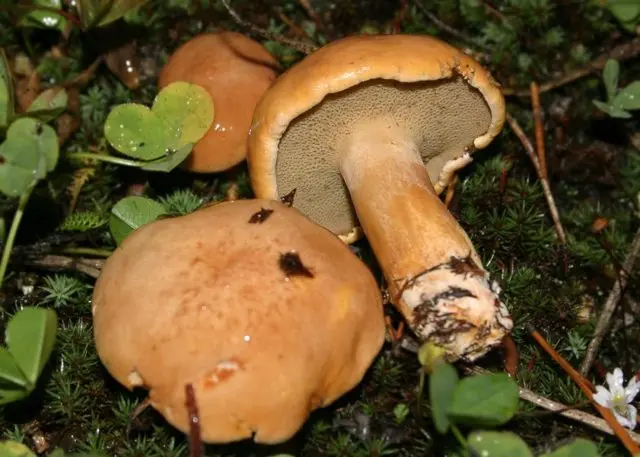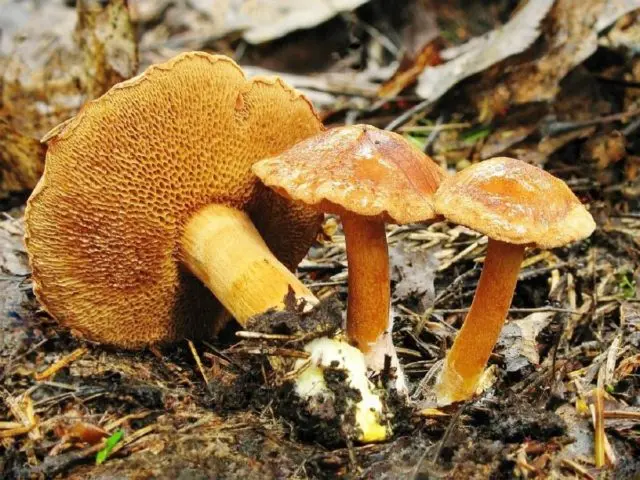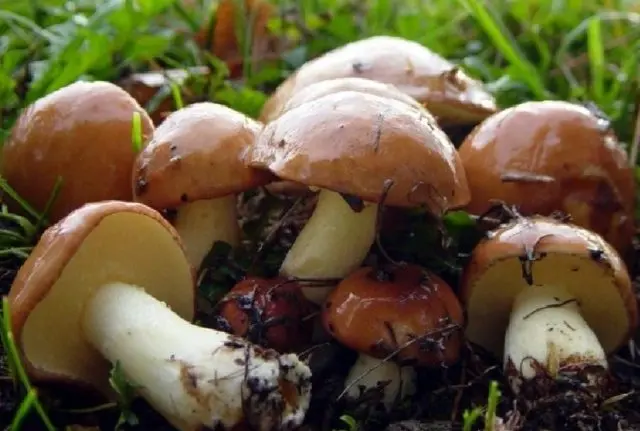Contents
Edible boletus are real “celebrities” among mushrooms that are harvested in domestic forests. There are about 50 species of them in nature, and although only a few of them are in demand among lovers of “silent hunting”, they are very much appreciated for their abundance, pleasant aroma and excellent taste. These mushrooms do not have truly toxic counterparts, however, it must be borne in mind that not all oils are recommended to be eaten. In addition, out of ignorance, one can confuse an edible mushroom with a completely different species, which may well be poisonous. The ability to distinguish false and edible butterflies from a photo will help the mushroom picker make the right choice from all the colorful variety that the summer and autumn forest offers, and put exactly what you need in the basket.
Are there false butterflies
In fact, there is no such species as a “false oiler” in the botanical classification. However, this is usually the name of those mushrooms that can easily be mistaken for the most popular types of edible oil in forests (ordinary, granular, larch). Some of these “twins” are edible conditionally, or there is no unambiguous opinion about the possibility of their consumption. A few more species can be eaten without fear, but their taste and aroma leave much to be desired.
It is worth dwelling on the name and appearance of such false butterflies, their photos and descriptions.
What mushrooms look like butterflies
Among mushrooms that look like common butter, you can most often encounter the following:
- Oil can yellow-brown. Edible, but not very tasty mushroom. He has a semicircular hat with a diameter of 5-14 cm, its edges are wrapped down. The color is gray-yellow or gray-orange. With age, it turns red, then becomes light ocher. The pores under the cap are small, painted in gray-yellow or brown-olive color. The length of the leg is 3-9 cm, it is smooth, thick (up to 3,5 cm in girth), usually lemon-yellow in color.
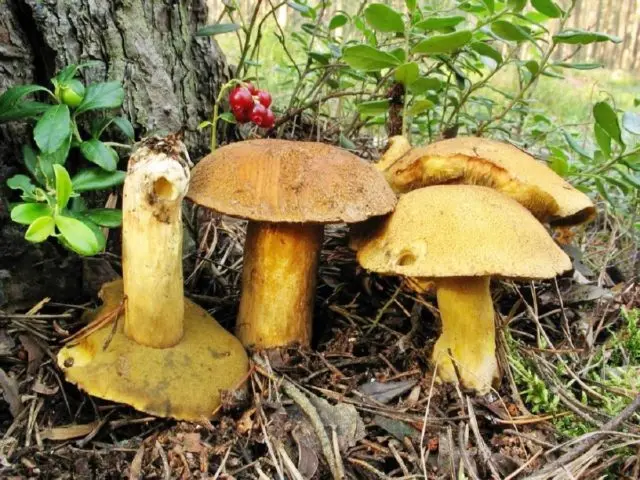
- Siberian butter dish. Information about him differs. According to one version, this false oiler is inedible, but not poisonous, according to another, it is edible, but does not have much nutritional value due to acidity and bitterness in taste. Its hat is 4-10 cm in diameter, light or dark yellow, covered with numerous reddish scales. In a young mushroom, it resembles a pillow, in an older one it acquires a convex shape, often with edges bent upwards and a tubercle in the middle. The skin on it is mucous, removed without difficulty. Leg from 0,5 to 2 cm thick and about 5-7 cm long, yellow with brown spots, not hollow inside. There is a fibrous ring on the stem that disappears over time.

- Butter dish dry, or goat. Edible, but bitter in taste, almost odorless. The cap diameter is 3-9 cm, it is yellow-brown, ocher or brown. In young mushrooms, it is whole, convex; in those that are older, it becomes flatter and cracks. The surface of the cap is slimy in rainy weather and dull, velvety when dry. The pores are large and irregular in shape. The thickness of the leg is small (1-2 cm), the length is 3-11 cm. It is hollow, it can be curved in shape. At the fracture site, the flesh of the leg turns blue, and the caps turn pink.

- Pepper moss (pepper). According to some data, this twin of the common butterdish is inedible, according to others it is classified as conditionally edible. It is named so because of the sharp, pungent taste of the pulp. Hat 2-8 cm in diameter, copper-red or “rusty” color, convex, rounded. Leg length 3-8 cm, thin (up to 1,5 cm), solid, can be bent. The pores are uneven, wide, in tone with the hat, but when pressed, they acquire a dark brown color.

- Mokruha spruce, or slug. Conditionally edible. The fleshy hat 4-10 cm in diameter in young mushrooms has the shape of a hemisphere, but over time it becomes convex-conical and even prostrate. Its color varies from gray-blue to gray-brown, while the middle is lighter than the edges. In an old mushroom, dark spots are noticeable on the surface of the cap. The leg is thick, massive, solid. Its length is 5-11 cm, the color of the lower part is usually bright yellow, and the upper part is grayish. The leg, like the cap, is densely covered with a layer of mucus, which glistens when dried.

Are there grebes that look like butterflies
Toadstool mushrooms are extremely difficult to confuse with butterflies. For example, the most toxic of them, pale, is characterized by a wide (up to 12 cm in diameter) convex cap of pale green, olive or white, covered with a white film. The leg of the pale grebe is long and thin (up to 1 cm). Just below the cap, it has a whitish fringed ring. From top to bottom, the leg thickens and passes into the volva – a dense shell in the form of an egg or bulb 3-5 cm thick.
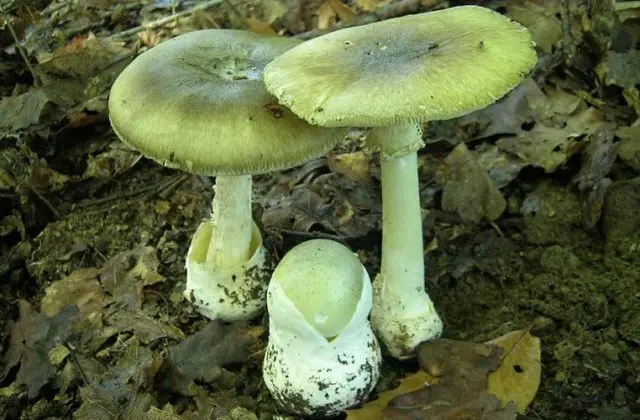
Toadstool does not belong to false butterflies. She has her own counterparts – russula, greenfinches, champignons, floats.
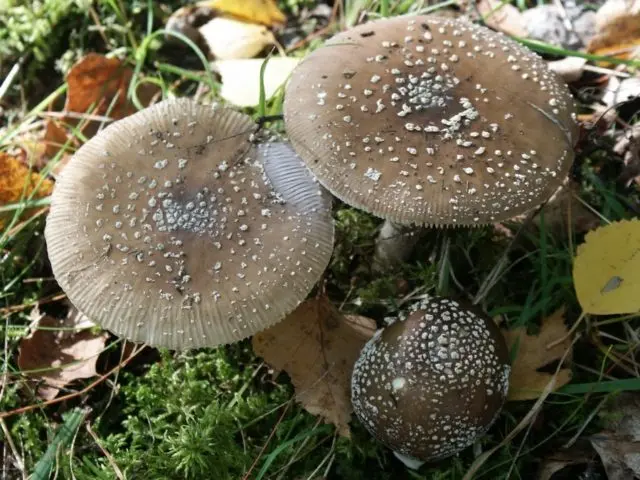
This toxic mushroom is not a false oiler, but an inexperienced mushroom picker may well be mistaken. Its most characteristic difference is the multiple convex white spots-warts covering the hat. In an edible butter dish, the hat is clean, evenly colored. Only sometimes weak stains are noticeable on it – a consequence of the sun’s “tan”.
How to distinguish butterflies from false butterflies
In order not to get into a mess, going on a “mushroom hunt”, you need to remember what “false” oilers are like, having carefully studied their photos and descriptions of characteristic features. Information about the chemicals contained in these mushrooms, their benefits or harm to the human body will be useful.
How oily oils differ from false oily ones in composition
The so-called “false” butternuts listed above are generally considered edible or conditionally edible. They are distinguished from ordinary ones by a less pleasant or specific taste, as well as the need for additional processing before cooking.
However, they are all very similar in chemical composition. Approximately 90% of their mass is water. The remaining 10% includes fiber, proteins, fatty acids, a rich set of vitamins and trace elements. According to the variety of amino acids, these mushrooms, both real and the mentioned “false”, are not inferior to meat. The protein content in their pulp is much higher than in any of the vegetables, however, due to the high concentration of chitin, it is absorbed by the human body worse than animal protein.
Butter is a low-calorie product that is very suitable for a diet.
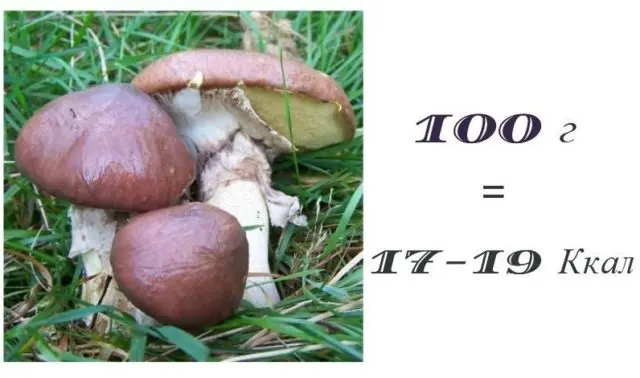
In addition, these mushrooms contain lactose, except for them, it is found only in products of animal origin. Rare sugars are also present in the pulp – mycosis, mycodextrin. In the fruiting bodies of these mushrooms, there is a very high concentration of vitamin B (as in butter) and PP (even higher than in yeast or liver).
Here is a brief comparative description of the compositional features of real and some types of conditionally false oil:
Luteus | Ordinary (real) | Goats (“false”) | yellow-brown (“false”) | Spruce mokruhi (“false”) |
Nutritional value (category) | II | III | III | IV |
Useful material | Resins, fats, carbohydrates, lecithin | Carotene, nebularin (antimicrobial substance) | Enzymes, essential oils | Carbohydrates, enzymes, natural antibiotics |
Trace Elements | Zinc, copper, phosphorus, magnesium, iron, iodine, manganese, potassium | Phosphorus | Molybdenum | potassium, phosphorus |
Vitamins | B, A, C, PP | B, D, RR | A, D, B, PP | B, C, E |
Kcal per 100 g (fresh product) | 17 – 19 | 20 | 19,2 | 19,2 |
How to distinguish false butterflies from edible ones in appearance
A number of sources call the pepper mushroom and the Siberian butterdish inedible “false” oils. It is worth figuring out what external features will give out their mushroom picker, who wants to fill the basket with only those mushrooms that can be eaten without fear.
How to identify butterdish fungus
The edible boletus are described and illustrated below. After examining the photo, it will become clear how to distinguish them from inedible and edible conditionally.
The three types of mushrooms that are most commonly found are:
- Butter dish real (ordinary, yellow, autumn, late). It is characterized by an oily-looking, convex hat with a small tubercle in the middle. It is covered with a mucous skin, painted in bright brown in various shades, from light to chocolate brown, and can reach 10-11 cm in diameter. The leg is thick (up to 3 cm), cylindrical in shape. Its length is about 10 cm, the lower part is brownish, the upper part is yellow. On the leg, a dark brown or purple membranous ring is clearly visible. The flesh is white-yellow, juicy in the cap, slightly fibrous in the stem.

- Butter dish granular (early, summer). Its cap is round-convex in shape, up to 10 cm in size, reddish-brown in a young mushroom and brightening to yellow-ocher color in an old one. The leg is up to 8 cm long, 1-2 cm thick, white-yellow in color, without a ring, in the upper part it is covered with convex “grains”. The pulp is dense, fragrant, yellowish-brown. The rounded pores of the tubular layer under the cap secrete white droplets of juice.

- Larch oiler. It has a glossy cap that is very brightly colored in yellow or orange tones. Its size varies from 3 to 10 cm, the shape is initially hemispherical, but flattens with age. The hat is covered with a smooth skin that glistens. The leg is firm, of medium thickness (up to 2 cm), can be from 4 to 8 cm long, even or curved. Its structure is fine-grained. At the top of the leg is a wide yellow ring. The pulp is yellowish, dense, with a pleasant fruity aroma.

What do false boletus look like
You can determine the “false” oiler by characteristic features. Each of these mushrooms has specific external features that help to recognize it:
- if there is no ring on the stem, and the spongy layer on the back of the cap has a reddish tint, most likely this “false” butter dish is a pepper jar;
- in the case when the hat is gray or pale purple, and its lower side, instead of tubes, is covered with plates thickly smeared with mucus, this may be spruce wet;
- in the “false” goat butterdish, the pores of the tubular layer are large, similar to bee honeycombs, there are no rings on the stem, and the surface of the cap of old mushrooms cracks;
- the Siberian butterdish is distinguished by a thick stem covered with ingrown fibers and a lighter cap with red-brown scales on it;
- if the hat is yellow-colored, dry, not oily, and even velvety to the touch, it is very likely that this “false” oiler is yellow-brown.
Differences oil and false oil when cut and to taste
To understand whether a real butter dish or a “false one”, one should not only study its top and bottom view, but also cut it.
Butter dish | Ordinary (real) | Yellow-brown (“false”) | Kozlyak (“false”) | Perechnik (“false”) | Siberian (“false”) | Mokruha spruce (“false”) |
Pulp | White or yellowish | yellow or orange | Pale yellow in the hat, pinkish in the stem | Yellow | Yellow | Pink |
Color at the cut | Doesn’t change color | Turns blue or purple | Leg – turns blue, hat – slightly reddens | Blushing | Doesn’t change color | Doesn’t change color |
Taste | Pleasant, “mushroom”, odorless or with the aroma of pine needles | No particular taste, “metallic” smell may be present | No special taste or slightly sour | Sharp, “peppered” | Pronounced sour | Sweetish, but can also be sour |
What are the similarities between edible and inedible mushrooms
Comparing photos of edible and inedible oil, it is easy to see how they are similar. Most of them have convex caps covered with slippery mucous skin (the exception is the “false” yellow-brown appearance), painted mainly in various shades of brown and red. The legs are usually cylindrical in shape and have a smooth or fibrous surface. They are of medium thickness and completely different heights (from 3 to 12 cm), depending on the size of the mushroom. Compared to the hats, they are colored lighter. Some species have a ring on the stem, others do not.
Conditionally called “false” butterflies, which really belong to the same genus of the Maslenkov family of the Boletov order, are tubular mushrooms. The exception is spruce mokruha. This “false oiler” is not really one. He is a representative of the Mokrukhov family of the Boletov order, this is an agaric mushroom.
For more information about spruce mokruha, where they grow and what these conditionally “false butterflies” are, the video will tell https://youtu.be/CwotwBZY0nw
Real and “false” types of habitat are related – pine plantations, as well as mixed forests, where, in addition to coniferous trees, a large number of oaks and birches grow. They love sunny clearings, grow well on forest edges and along roads, often hiding under fallen pine needles. They are found almost everywhere in the cool temperate climate of central and northern Our Country.
Both real and “false” butterflies most often grow in groups, although single specimens can also be found. In abundance, they appear two to three days after the rain. These mushrooms are also loved by generous morning dews.

In general, the oil season falls on the period from June to October, but the peak of the simultaneous appearance of their various species falls on August-September.
What harm can false oils cause to the body
It should be remembered that, although “false” oils are not toxic and deadly, if improperly cooked, they will almost certainly become a source of health problems.
Old, overripe and worm-tainted mushrooms are relatively dangerous: they can cause allergies or intestinal upset. For this reason, you should not collect the largest specimens – it is best to put small or medium ones (up to 8 cm) in the basket, choosing strong, whole and untouched by insects.
In addition, it is oilseeds, both “false” and real, collected near highways or near industrial enterprises, that accumulate toxins, heavy metal salts and other harmful substances in their fruiting bodies. Even soaking and heat treatment are not able to get rid of them. In such places, mushrooms should not be collected at all.
Are there poisonous oils
There are no truly poisonous oils in nature. However, there is a possibility that a poisonous mushroom of a completely different kind, mistakenly taken by him for a butter dish, may fall into the basket of an amateur mushroom picker. Therefore, you should go on a “silent hunt” with good theoretical knowledge and practical skills, or take an experienced friend into the company.
Safety measures
Edible varieties of butter, not only “false”, but also real ones, are recommended to be peeled before cooking in order to avoid intestinal disorders.
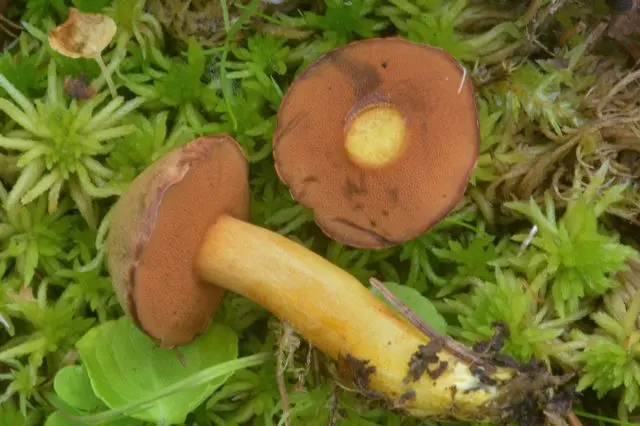
As for conditionally edible species, before eating, you need to boil them for 20-30 minutes in boiling salted water. Then the broth must be drained, and the mushrooms should be used further in accordance with the culinary recipe.
It is very desirable to deal with the processing of oil and the preparation of dishes from them directly on the day of collection, in extreme cases – in the morning of the next day. These mushrooms, both real and false, are highly perishable. They quickly become breeding grounds for bacteria. It is especially important not to forget about this when harvesting butter for the winter in the form of home canned food.
To store salted or pickled butter (both real and “false”), in no case should galvanized or ceramic glazed containers be used. This can contribute to the accumulation of high concentrations of lead and zinc in the finished mushroom dish, which is dangerous for the human body.
Conclusion
Knowing how to distinguish false and edible butterflies from a photo, and being able to recognize their most common species by their characteristic features, you can confidently follow them into the forest. These mushrooms do not have poisonous twins. You can collect not only real boletus, but also many of those that are popularly called “false”. Some of them are quite suitable for food, some are conditionally edible species, they require preliminary boiling before use. Mushrooms such as pepperwort or Siberian butterdish, the edibility of which is the subject of a dispute, are still better not to cut: in season you can find other types of butternuts that are tastier and safer. You also need to remember that it is important not only to correctly identify the mushroom before taking it to your basket, but also to know how to properly process and cook it. Then the prey from the “quiet hunt” on the table will really give pleasure and will not create health problems.










